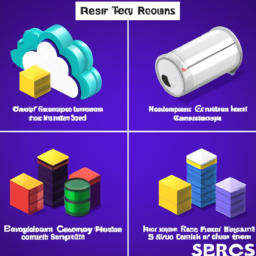What Are Microservices And How Can They Benefit My Business?
Imagine a world where you can streamline your business operations, improve scalability, and accelerate innovation all at once. Sounds enticing, right? Well, that’s precisely what microservices offer. In this article, we’ll explore the concept of microservices and uncover how they can revolutionize your business. So, sit back and get ready to unlock the potential of microservices as we embark on a journey towards increased agility and enhanced customer satisfaction.
What Are Microservices
Definition of microservices
Microservices, also known as the microservice architecture, is a software development approach that structures an application as a collection of loosely coupled services. Each service is built around a specific business capability and can be developed and deployed independently. Unlike traditional monolithic architectures, where the entire application is built as a single unit, microservices are smaller, self-contained components that communicate with each other through API calls.
Characteristics of microservices
Microservices have several key characteristics that set them apart from monolithic architectures. Firstly, each microservice is responsible for a specific functionality or business capability, allowing for better modularity and separation of concerns. This means that if one service fails or needs to be updated, it can be done without affecting the other services.
Secondly, microservices are organized around business domains and can be developed, deployed, and scaled independently. This enables greater agility and flexibility in responding to changing business requirements.
Another characteristic of microservices is that they communicate with each other using lightweight protocols such as HTTP or messaging queues. This allows for loose coupling between services, making it easier to modify or replace individual services without disrupting the entire system.
Lastly, microservices typically have their own dedicated databases, which contributes to improved fault isolation and minimizes the risk of data corruption or loss.
Benefits of Microservices
Scalability
One of the primary benefits of microservices is improved scalability. With traditional monolithic architectures, scaling the application often requires scaling the entire system, even if only a specific functionality or service needs additional resources. In contrast, microservices allow for granular scalability, where resources can be allocated based on the demand of individual services. This enables organizations to optimize resource utilization and save costs by scaling only the necessary components.
Flexibility
Microservices offer greater flexibility in terms of development, deployment, and technology choices. Since each microservice is independent, development teams can choose different languages, frameworks, and databases based on the specific needs of the service. This allows organizations to use the most suitable technology for each component, resulting in improved productivity and efficiency.
Furthermore, the decoupled nature of microservices simplifies the deployment process. Services can be deployed independently, which means updates or bug fixes can be rolled out without disrupting the entire system. This flexibility enables organizations to adopt a continuous deployment approach, where new features or improvements can be released more frequently, leading to faster innovation and competitive advantage.
Improved fault isolation
In traditional monolithic architectures, a single bug or failure in one component can bring down the entire system. Microservices, on the other hand, promote fault isolation. Since each service operates independently, the failure of one service does not impact the others. This allows for easier troubleshooting and debugging, as issues can be isolated to a specific service rather than affecting the entire application.
Additionally, microservices often have their own dedicated databases, reducing the risk of data corruption or loss in case of a failure. With separate databases, it is easier to restore data and minimize the impact on other services.
Ease of deployment
Microservices simplify the deployment process by allowing independent and isolated deployments of individual services. This means that updates, bug fixes, or new features can be deployed without disrupting the entire system. The decoupled nature of microservices also enables teams to adopt agile practices such as continuous deployment, where changes can be released rapidly, leading to faster time-to-market and better responsiveness to customer needs.
Independent development
Microservices enable independent development, which can significantly improve the efficiency and agility of development teams. Since each microservice represents a specific business capability or functionality, development teams can work on their services without being dependent on other teams. This allows for faster development cycles, efficient use of resources, and easier integration of new team members or third-party services.
Independent development also promotes decentralized decision-making and empowers teams to make technology and architecture choices that best suit the requirements of their services. This fosters innovation and allows organizations to adapt quickly to changing market demands.
Efficient resource utilization
Microservices can optimize resource utilization by allowing granular scaling and allocation of resources based on demand. Instead of scaling the entire system, organizations can allocate resources specifically to the services that need them, resulting in improved efficiency and cost savings. Additionally, microservices allow teams to use different technology stacks for different services, enabling them to choose the most appropriate technology for a specific task or requirement. This further enhances resource utilization by ensuring that services are developed and deployed using the most efficient technologies available.
Implementing Microservices
Identifying appropriate services
When implementing microservices, it is crucial to identify the appropriate services that align with the business capabilities and requirements of the application. This involves breaking down the existing monolithic application into smaller, more manageable services. The goal is to identify the boundaries of each service and determine the best way to decompose the functionality.
It is important to consider factors such as independent scalability, autonomy, and business requirements when defining the services. By identifying the appropriate services, organizations can ensure that each microservice is focused on a specific task or business capability, leading to greater flexibility and improved agility.
Deciding on communication protocol
Communication between microservices is a critical aspect of the architecture. Organizations need to decide on the communication protocol that best aligns with their requirements and ensures efficient interaction between services. There are several options available, including synchronous HTTP/REST, asynchronous messaging (such as RabbitMQ or Apache Kafka), or event-driven architectures.
The choice of communication protocol depends on factors such as the complexity of interactions, performance requirements, and the tolerance for eventual consistency. It is important to thoroughly evaluate the pros and cons of each protocol and select the most suitable one that aligns with the needs of the application.
Designing APIs
API design plays a crucial role in the success of microservices. Well-designed APIs ensure loose coupling between services and allow for seamless integration with external systems or third-party services. When designing APIs, it is important to follow best practices such as using clear and consistent naming conventions, providing appropriate documentation, and considering versioning and backward compatibility.
By designing APIs that are intuitive, easy to use, and well-documented, organizations can simplify the integration process and promote the adoption of their services by other teams or external developers.
Securing microservices
Security is a critical aspect of any application architecture, and microservices are no exception. When implementing microservices, it is important to consider security measures such as authentication, authorization, and encryption. Each microservice should have appropriate security mechanisms in place to protect sensitive data and prevent unauthorized access.
Organizations should also consider implementing measures such as rate limiting, throttling, and monitoring to detect and mitigate potential security threats. By proactively addressing security concerns, organizations can ensure the robustness and integrity of their microservices architecture.
Challenges of Microservices
Increased complexity
While microservices offer numerous benefits, they also introduce increased complexity compared to traditional monolithic architectures. With multiple services interacting with each other, managing the dependencies and interactions can become challenging. Organizations need to carefully plan and design the architecture to ensure that the complexity is managed effectively.
Additionally, as the number of services increases, monitoring and debugging become more complex. Organizations need to invest in robust monitoring and debugging tools to ensure that they can easily identify and resolve issues in the microservices environment.
Monitoring and debugging
Monitoring and debugging microservices can be more challenging compared to monolithic architectures. With numerous services running independently, tracking and understanding the flow of data and requests can become complex. Organizations need to implement comprehensive monitoring and logging strategies to capture and analyze the necessary data.
Additionally, debugging issues in a microservices environment requires specialized tools and techniques. Organizations should invest in tools that allow them to trace and identify issues across different services and quickly resolve them to minimize downtime and impact on users.
Data management across services
Managing data across multiple services can be a complex task. Each microservice may have its own dedicated database, and ensuring data consistency and integrity can become challenging. Organizations need to carefully design and implement data management strategies that address issues such as data synchronization, data replication, and eventual consistency.
It is important to consider factors such as data ownership, data access, and data sharing when designing the data management approach. By carefully managing data across services, organizations can ensure that the microservices architecture operates effectively and delivers the expected business results.
Team and organizational challenges
Implementing a microservices architecture can introduce team and organizational challenges. The decentralized nature of microservices means that different teams are responsible for developing and maintaining individual services. This requires clear communication and coordination among teams to ensure seamless integration and alignment of services.
Furthermore, organizational structures may need to evolve to support the decentralized decision-making and autonomy of teams. This may require changes in roles, responsibilities, and reporting structures to ensure efficient collaboration and governance.
Use Cases of Microservices
E-commerce
Microservices architecture is well-suited for e-commerce platforms. By decomposing the monolithic e-commerce system into smaller, autonomous services, organizations can achieve greater flexibility and scalability. Each service can be responsible for a specific functionality, such as catalog management, order processing, payment processing, or customer management.
Microservices architecture enables e-commerce platforms to handle high volumes of traffic and rapidly adapt to changing market trends. It allows for seamless integration with third-party services or marketplaces, ensuring a seamless shopping experience for customers.
Financial services
The financial services industry can greatly benefit from microservices architecture. Each service can cater to a specific financial product or functionality, such as banking transactions, credit scoring, risk assessment, or fraud detection. By decomposing the monolithic financial system into smaller services, organizations can achieve better scalability, flexibility, and fault isolation.
Microservices architecture allows financial institutions to quickly introduce new products or services, integrate with external providers, and adapt to changing regulatory requirements. It also enables the use of advanced analytics and machine learning algorithms for real-time decision-making and risk management.
Travel and hospitality
Microservices architecture can revolutionize the travel and hospitality industry by enabling more personalized and seamless experiences for travelers. Each microservice can cater to specific functionalities, such as flight booking, hotel reservations, car rentals, or itinerary management.
By decomposing the monolithic travel system into smaller, specialized services, organizations can offer customized travel experiences and rapidly adapt to changes in demand or availability. Microservices architecture also allows for easy integration with third-party services, such as airline APIs or hotel aggregators, enabling travel platforms to provide comprehensive services to their customers.
Social media platforms
Microservices architecture is well-suited for social media platforms, where users generate and consume vast amounts of data in real-time. Each microservice can handle a specific functionality, such as user authentication, content creation, content recommendation, or social connections.
By decomposing the monolithic social media system into smaller, autonomous services, organizations can achieve better scalability, flexibility, and fault isolation. Microservices architecture allows social media platforms to handle high volumes of user activity, seamlessly integrate with external services (such as image recognition or sentiment analysis APIs), and rapidly deliver personalized content to users.
Best Practices for Microservices
Single responsibility principle
One of the key principles of microservices architecture is the single responsibility principle. Each microservice should have a clear and well-defined responsibility, focusing on a specific business capability or functionality. This promotes modular design, loose coupling, and better scalability.
By adhering to the single responsibility principle, organizations can ensure that each microservice is focused and easy to understand. It also enables independent development, deployment, and scaling of services, leading to improved agility and maintainability.
Containerization
Containerization is a crucial practice when implementing microservices architecture. Containers, such as Docker, allow services to be packaged with their dependencies and run consistently across different environments. This ensures that services can be easily deployed and scaled, regardless of the underlying infrastructure.
Containerization also promotes portability and flexibility, as containers can be easily moved between different hosting platforms or environments. It simplifies the deployment process and minimizes compatibility issues, enabling organizations to adopt a DevOps approach and streamline their development and operations workflows.
Continuous integration and deployment
Continuous integration and deployment (CI/CD) is a best practice that can greatly enhance the efficiency and speed of developing and delivering microservices. CI/CD enables teams to integrate their code changes frequently and automatically build, test, and deploy the services.
By automating the build and deployment process, organizations can ensure a rapid and reliable release cycle. CI/CD pipelines allow for quick feedback loops, early bug detection, and seamless integration of new features or fixes. This reduces the risk of deployment failures, accelerates time-to-market, and improves overall productivity.
Monitoring and logging
Monitoring and logging are critical practices for managing and maintaining microservices architecture. Comprehensive monitoring ensures that organizations have visibility into the performance, availability, and health of their services. It allows them to identify and resolve issues before they impact users or business operations.
Logging, on the other hand, provides a detailed record of events and activities within the microservices environment. It helps troubleshoot and debug issues, track user behavior, and analyze system performance.
Organizations should invest in monitoring and logging tools that provide real-time insights, alerting capabilities, and scalability to handle the large volumes of data generated by microservices.
Versioning and backward compatibility
Versioning and backward compatibility are important considerations when implementing microservices. As services evolve and new versions are released, it is crucial to ensure that existing clients can continue to access the services without disruption.
By properly versioning the APIs and managing backward compatibility, organizations can mitigate the risk of breaking changes and minimize the impact on clients. This allows for seamless integration with external systems or third-party services, ensuring a smooth transition during service updates or enhancements.
Tools and Technologies for Microservices
Service discovery tools
Service discovery tools enable services to dynamically locate and communicate with each other within a microservices architecture. These tools maintain a registry of available services, allowing other services to discover and interact with them through well-defined APIs.
Examples of service discovery tools include Consul, Eureka, and ZooKeeper. These tools provide features such as service registration, health checks, load balancing, and failover, ensuring that services can efficiently communicate and collaborate within the architecture.
API gateways
API gateways act as a centralized entry point for clients to access the various microservices. They provide a layer of abstraction and handle tasks such as authentication, routing, and request throttling. API gateways also enforce security policies and enable organizations to centrally manage and monitor the APIs.
Popular API gateway tools include Kong, Apigee, and Amazon API Gateway. These tools provide features such as request routing, rate limiting, metrics monitoring, and logging, making it easier to manage the interactions between services and clients.
Container orchestration platforms
Container orchestration platforms, such as Kubernetes and Docker Swarm, help organizations manage and scale their containerized microservices. These platforms provide features for automated deployment, scaling, load balancing, and monitoring of containers.
By using container orchestration platforms, organizations can easily manage the lifecycle of their microservices, optimize resource utilization, and ensure high availability and fault tolerance.
Message brokers
Message brokers facilitate asynchronous communication between microservices. They provide reliable messaging mechanisms to decouple services and enable scalable event-driven architectures.
Popular message broker tools include Apache Kafka, RabbitMQ, and Apache ActiveMQ. These tools support features such as message persistence, pub/sub messaging, and robust event processing, enabling organizations to build resilient and event-driven microservices architectures.
Microservices vs Monolithic Architecture
Differences in architecture
Microservices and monolithic architectures represent two different approaches to software development and system design.
In a monolithic architecture, the entire application is built as a single, tightly integrated unit. The application typically consists of multiple layers, such as the presentation layer, business logic layer, and data access layer, tightly coupled together. Monolithic architectures are characterized by their simplicity and ease of development, as all functionality is contained within a single codebase.
On the other hand, microservices architecture promotes the decomposition of the monolithic application into smaller, autonomous services. Each service is responsible for a specific functionality or business capability and can be developed, deployed, and scaled independently. Microservices are loosely coupled and communicate with each other using lightweight protocols.
Advantages of monolithic architecture
Monolithic architectures offer simplicity and ease of development. With all functionality contained within a single codebase, it is easier to develop, test, and deploy the application. Monolithic architectures also have less complexity in terms of integration and communication between components, as everything is contained within the same system.
Additionally, monolithic architectures can be more suitable for small- to medium-sized applications with straightforward requirements. They are often favored when time-to-market is critical and there is a need for rapid development and deployment.
Advantages of microservices architecture
Microservices architecture offers several advantages over monolithic architectures. Firstly, microservices promote modularity and separation of concerns. Each service is focused on a specific functionality or business capability, making it easier to develop, test, and maintain. This allows for faster development cycles and improved agility.
Secondly, microservices enable independent development, deployment, and scaling. Services can be developed and deployed independently, allowing for faster release cycles and easier adoption of new features or fixes. Microservices also enable fine-grained scaling, where resources can be allocated specifically to the services that need them, leading to better resource utilization.
Furthermore, microservices architecture allows organizations to leverage different technologies and frameworks for different components. This enables teams to choose the most suitable technology for each service, leading to improved efficiency and productivity.
Lastly, microservices enable fault isolation. With each service operating independently, the failure of one service does not impact the others. This allows for easier troubleshooting and debugging, as issues can be isolated to a specific service rather than affecting the entire application.
Real-world Examples of Microservices
Netflix
Netflix is a prime example of a company that has successfully embraced microservices architecture. Netflix has a highly distributed architecture with numerous microservices working together to provide its streaming platform. Each microservice is responsible for a specific functionality, such as content recommendations, user management, billing, or video streaming.
By implementing microservices, Netflix has achieved the ability to scale rapidly, deliver personalized recommendations, and handle high volumes of traffic. The modular architecture enables independent development and deployment of services, ensuring continuous innovation and customer satisfaction.
Uber
Uber, the ride-hailing giant, relies on microservices architecture to power its platform. The Uber platform consists of various microservices, including user authentication, ride matching, payment processing, and driver management.
Microservices architecture allows Uber to handle the complexity of managing millions of rides and users across different cities. The decentralized nature of microservices enables rapid feature development and scaling of specific services based on demand.
Amazon
Amazon, one of the largest online retailers, relies heavily on microservices architecture to power its e-commerce platform. Amazon has multiple microservices responsible for different functions, such as product catalog management, order processing, payment handling, and recommendation engines.
Microservices architecture allows Amazon to handle the high volumes of traffic, provide personalized shopping experiences, and rapidly adapt to changing market trends. The modular architecture enables independent development, deployment, and scaling of services, ensuring a seamless shopping experience for customers.
Spotify
Spotify, the popular music streaming service, has embraced microservices architecture to deliver its platform. Spotify has numerous microservices responsible for functions such as user authentication, music recommendation, playlist creation, and content delivery.
Microservices architecture enables Spotify to handle the complexity of managing millions of songs, playlists, and users. The modular architecture allows for rapid feature development, continuous integration, and seamless integration with external music providers.
Future Trends in Microservices
Serverless computing
Serverless computing, also known as Function-as-a-Service (FaaS), is a trend that complements microservices architecture. With serverless computing, organizations can focus solely on writing and deploying functions or microservices without the need to manage the underlying infrastructure.
Serverless computing abstracts away the infrastructure concerns, automatically scaling the functions based on demand and charging only for the actual usage. This allows organizations to focus on building and delivering business logic without the complexities of managing and scaling the underlying infrastructure.
AI and machine learning integration
The integration of AI and machine learning capabilities within microservices architecture is a future trend that can greatly enhance the capabilities of applications. By leveraging AI and machine learning algorithms, organizations can automate and enhance various processes, such as recommendations, fraud detection, or sentiment analysis.
Microservices architecture allows for the seamless integration of AI and machine learning services into the overall application ecosystem. Each AI or machine learning service can be developed and deployed independently, enabling organizations to continuously improve and optimize their applications.
Edge computing
Edge computing, which involves processing and storing data closer to the source rather than relying solely on centralized cloud infrastructure, is another trend that complements microservices architecture. With the proliferation of Internet of Things (IoT) devices and the need for real-time processing, edge computing enables faster response times and reduced latency.
Microservices architecture can be leveraged to deploy and manage microservices at the edge of the network, closer to the IoT devices or end-users. This enables organizations to take advantage of the benefits of microservices, such as modularity, scalability, and fault isolation, while being able to process and analyze data in real-time at the edge.
In conclusion, microservices architecture offers numerous benefits for businesses seeking to build scalable, flexible, and efficient applications. By decomposing monolithic applications into smaller, autonomous services, organizations can achieve improved scalability, fault isolation, and independent development and deployment. However, implementing microservices comes with its own set of challenges, such as increased complexity and data management across services. By following best practices and leveraging appropriate tools and technologies, organizations can successfully implement and benefit from microservices architecture. The future of microservices holds exciting trends, including serverless computing, AI and machine learning integration, and edge computing, which further enhance the capabilities and possibilities of this architectural approach.








